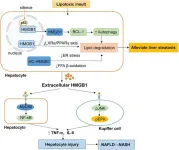(Press-News.org) The biomarker human neutrophil lipocalin HNL, which was previously shown to be a useful indicator of bacterial infections, may also in the form of Dimeric HNL be used to effectively monitor the success of antibiotic treatment in sepsis. The first promising results in this regard were published in 2019 and now the research group has confirmed these results in a larger study. The study is published in the journal PLOS ONE.
Sepsis, the costliest disease to health care, is a life-threatening condition with high mortality if not diagnosed and treated early and effectively. Mostly the cause is a bacterial infection. Thus, early and effective antibiotic treatment is lifesaving. The use of broad-spectrum antibiotics increases the likelihood of an effective treatment but may also add to the development of antibiotic resistance. The 2013 World Economic Forum classified antibiotic resistance as one of the biggest threats to global health. 1.27 million deaths were caused directly by antimicrobial resistance in 2019 and 13.66 million had sepsis as an immediate or intermediate cause of death. https://www.healthdata.org/research-analysis/health-risks-issues/antimicrobial-resistance-amr.
In a new study the scientists wanted to investigate if the use of HNL Dimer as a blood biomarker would be useful in the monitoring of antibiotic treatment of patients with sepsis and provide more reliable and faster response than the currently used biomarkers.
The investigation was conducted on 277 patients admitted to the intensive care unit. Blood was drawn at admission and the next three consecutive days and later analysed in the laboratory. For comparison with HNL Dimer, several other blood biomarkers were analysed for the purpose of following their kinetics during successful antibiotic treatment. These were Procalcitonin, Heparin-Binding Protein and CRP (C-Reactive Protein) and are all highly elevated in blood in patients with bacterial infections such as sepsis.
“The problem, however, with these biomarkers is that it often takes 4-5 days of successful treatment before any reduction in blood levels is seen. The levels of HNL Dimer are reduced much faster and often within a day of successful antibiotic treatment. Thus, by measuring HNL Dimer in blood in our patients we may gain important time savings of 3-4 days before we know the result of our antibiotic treatment” says Per Venge, MD and professor in Clinical Chemistry at the University of Uppsala in Sweden and who has conducted research for many years on Human Neutrophil Lipocalin as a biomarker of disease.
The assay of HNL Dimer is developed in close collaboration between Uppsala University and the company Diagnostics Development in Uppsala.
END
Faster measurement of response to antibiotic treatment in sepsis patients using Dimeric HNL
2024-11-08
ELSE PRESS RELEASES FROM THIS DATE:
Cleveland Clinic announces updated findings in preventive breast cancer vaccine study
2024-11-08
November 8, 2024, CLEVELAND: Cleveland Clinic researchers are presenting updated findings from their novel study of a vaccine aimed at preventing triple-negative breast cancer, the most aggressive and lethal form of the disease.
The study team found that the investigational vaccine was generally well tolerated and produced an immune response in most patients. The team described the side effects of the vaccine, showed the highest tolerated dose to date, and presented the immunologic effects of the vaccine. Findings are being presented at the Society for Immunotherapy of Cancer Annual Meeting.
Launched in 2021 and funded by the U.S. Department of Defense, the ongoing ...
Intergenerational effects of adversity on mind-body health: Pathways through the gut-brain axis
2024-11-08
The Brain & Behavior Research Foundation (BBRF) is hosting a free webinar, “Intergenerational Effects of Adversity on Mind-Body Health: Pathways Through the Gut-Brain Axis” on Tuesday, November 12, 2024, at 2:00 pm ET. The presenter, Bridget Laura Callaghan, Ph.D., is an Assistant Professor in the Department of Psychology at the University of California, Los Angeles (UCLA). At UCLA, Dr. Callaghan directs the Brain & Body Lab in the Department of Psychology and also heads the Mental Disorders and Pain research theme at the Goodman Luskin Microbiome Center. The webinar host, Jeffrey Borenstein, M.D., is the President ...
Watch this elephant turn a hose into a sophisticated showering tool
2024-11-08
Tool use isn’t unique to humans. Chimpanzees use sticks as tools. Dolphins, crows, and elephants are known for their tool-use abilities, too. Now a report in the Cell Press journal Current Biology on November 8, 2024, highlights elephants’ remarkable skill in using a hose as a flexible shower head. As an unexpected bonus, researchers say they also have evidence that a fellow elephant knows how to turn the water off, perhaps as a kind of “prank.”
“Elephants are amazing with hoses,” says Michael Brecht ...
Chimpanzees perform better on challenging computer tasks when they have an audience
2024-11-08
When people have an audience watching them, it can change their performance for better or worse. Now, researchers reporting in the Cell Press journal iScience on November 8 have found that chimpanzees’ performance on computer tasks is influenced by the number of people watching them. The findings suggest that this “audience effect” predates the development of reputation-based human societies, the researchers say.
“It was very surprising to find that chimpanzees are affected in their task performance by ...
New medical AI tool identifies more cases of long COVID from patient health records
2024-11-08
KEY TAKEAWAYS
Researchers from Mass General Brigham are leveraging artificial intelligence to help identify the signs of long COVID, track how different symptoms manifest over time, and eliminate alternative explanations for patients’ symptoms.
The new approach suggests that 22.8% of the population experience the symptoms of long COVID, a figure that may paint a more realistic picture of the pandemic’s long-term toll.
Through analyzing a patient’s history over time, this new AI tool ...
Heat waves and adverse health events among dually eligible individuals 65 years and older
2024-11-08
About The Study: In this time-series study, heat waves were associated with increased adverse health events among dually eligible individuals 65 years and older. Without adaptation strategies to address the health-related impacts of heat, dually eligible individuals are increasingly likely to face adverse outcomes.
Corresponding Author: To contact the corresponding author, Hyunjee Kim, PhD, email kihy@ohsu.edu.
To access the embargoed study: Visit our For The Media website at this link https://media.jamanetwork.com/
(doi:10.1001/jamahealthforum.2024.3884)
Editor’s Note: Please ...
Catastrophic health expenditures for in-state and out-of-state abortion care
2024-11-08
About The Study: In this cross-sectional study of U.S. patients seeking abortion, many individuals and their households were estimated to incur catastrophic health expenditures, particularly those traveling from out of state. The financial and psychological burdens of abortion seeking have likely worsened after the Dobbs decision, as more people need to cross state lines to reach abortion care. The findings suggest expansion of insurance coverage to ensure equitable access to abortion care, irrespective of people’s state of residence, ...
State divorce laws, reproductive care policies, and pregnancy-associated homicide rates
2024-11-08
About The Study: In this cross-sectional study of pregnancy-associated homicide rates, barriers to divorce were associated with higher homicide rates and access to reproductive health care was associated with lower homicide rates. This study highlights the association between state legislation and pregnancy-associated homicide in the U.S., which is important information for policymakers.
Corresponding Author: To contact the corresponding author, Kaitlin M. Boyle, PhD, email kb49@mailbox.sc.edu.
To access the embargoed study: Visit our For The Media website at this link https://media.jamanetwork.com/
(doi:10.1001/jamanetworkopen.2024.44199)
Editor’s ...
Emerging roles of high-mobility group box-1 in liver disease
2024-11-08
Liver diseases, both acute and chronic, continue to pose significant clinical challenges due to high morbidity and mortality rates. Acute liver injury (ALI) caused by acetaminophen (APAP) overdose, hepatic ischemia-reperfusion injury (HIRI), and chronic conditions like nonalcoholic fatty liver disease (NAFLD) and alcohol-associated liver disease (ALD) are influenced by HMGB1-mediated pathways. HMGB1 is released from injured or necrotic liver cells and triggers inflammatory responses. Its circulating levels have been associated with disease severity in liver conditions, marking ...
Exploring the systematic anticancer mechanism in selected medicinal plants
2024-11-08
Cancer remains one of the leading global causes of mortality, with an estimated increase in cases due to lifestyle, environmental, and genetic factors. Despite advancements in treatment, cancer's complexity and the side effects of conventional therapies necessitate alternative approaches. Medicinal plants, long valued for their therapeutic properties, have shown promise in cancer treatment, attributed to their natural phytoconstituents. This review focuses on the anticancer mechanisms of specific medicinal plants and discusses their potential for future therapeutic development.
Anticancer Mechanisms of Selected Medicinal Plants
Medicinal plants exert anticancer ...



